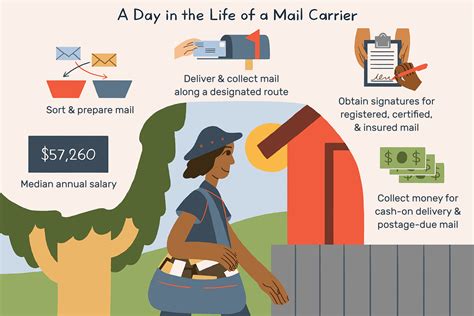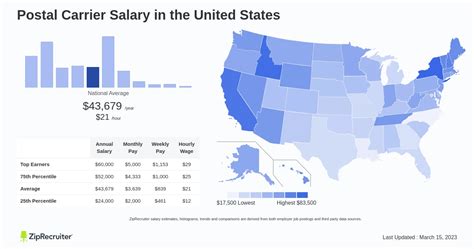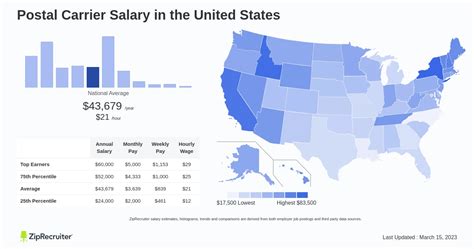A career as a postal carrier for the United States Postal Service (USPS) is more than just a job; it's a vital public service and a path to a stable, middle-class life. For those seeking a profession with structured pay, excellent benefits, and the opportunity to work independently while serving their community, becoming a postal carrier is an attractive option.
But what can you realistically expect to earn? While the image of the friendly neighborhood mail carrier is timeless, their compensation is modern, structured, and influenced by several key factors. This guide will break down postal carrier salaries, from your first day as an assistant to your final years as a seasoned veteran. On average, a postal carrier can expect to earn a median salary of around $57,000 to $59,000 per year, with a typical range falling between $45,000 and $72,000 annually, including overtime.
Let's deliver the details on how that pay is calculated.
What Does a Postal Carrier Do?

Before we dive into the numbers, it's important to understand the role. A postal carrier, also known as a mail carrier or letter carrier, is the public face of the USPS. Their primary responsibility is the timely and accurate delivery of mail and packages to residences and businesses along a designated route.
Key responsibilities include:
- Sorting mail for their specific route.
- Loading mail and packages into their delivery vehicle.
- Driving or walking along routes to deliver mail.
- Collecting outgoing mail from mailboxes.
- Using handheld electronic scanners to track packages and confirm deliveries.
- Providing excellent customer service, answering questions, and selling postal products like stamps.
The job is physically demanding, requiring individuals to work in all weather conditions and be on their feet or driving for most of the day.
Average Postal Carrier Salary

When looking at salary data, it's helpful to consult multiple sources to get a complete picture. The compensation for postal carriers is highly structured, but data aggregators provide a useful snapshot of what current employees are earning.
- The U.S. Bureau of Labor Statistics (BLS) reports that the median annual wage for Postal Service Mail Carriers was $57,790 in May 2023. The lowest 10 percent earned less than $40,150, and the highest 10 percent earned more than $72,230.
- Salary.com places the average salary for a Mail Carrier in the United States at $58,981 as of May 2024, with a typical range between $53,197 and $66,632.
- Glassdoor estimates the total pay for a USPS Mail Carrier to be around $59,000 per year on average, combining a base salary of approximately $53,000 with additional pay like overtime and bonuses.
It's crucial to note that new hires often begin as non-career employees, such as a City Carrier Assistant (CCA), who are paid a fixed hourly rate (currently starting at $19.33 per hour). Upon conversion to a full-time "career" position, they are placed on a formal pay scale with guaranteed raises.
Key Factors That Influence Salary

Unlike many private-sector jobs, a postal carrier's salary is not typically open to negotiation. Instead, it is determined by a transparent and predictable set of factors, largely governed by union agreements with the USPS.
Years of Experience
This is arguably the most significant factor in determining a postal carrier's income. The USPS operates on a clear, step-based pay system. Once an employee achieves "career" status, they are placed on a pay grade and begin advancing through a series of steps.
For example, according to the 2023-2027 pay chart from the National Association of Letter Carriers (NALC), a new career City Carrier starts at Grade 1, Step AA. They then receive automatic, contractually obligated pay increases as they accumulate years of service, progressing through steps (A, B, C, etc.) up to a maximum of Step P after approximately 15 years. This system ensures that loyalty and experience are directly rewarded with higher pay, providing a clear path for salary growth over a lifetime career.
Geographic Location
Where you work matters. The federal government, including the USPS, uses a locality pay system to adjust salaries for employees in areas with a higher cost of living. This means a carrier working in a major metropolitan area like San Francisco or New York City will earn a higher base salary than a carrier in a rural, low-cost-of-living area. These locality adjustments are designed to ensure that federal employees nationwide have comparable purchasing power. You can find these adjustments on the U.S. Office of Personnel Management (OPM) website, which shows the percentage increase applied to base pay in different regions.
Company Type (Role and Union)
While most postal carriers work for the USPS, their specific role and union affiliation create different pay structures.
- City Carriers: These employees work in urban and suburban areas and are represented by the National Association of Letter Carriers (NALC). They are typically paid hourly, and their path from CCA to career status and progression through the pay steps is well-defined.
- Rural Carriers: These carriers serve rural and exurban routes and are represented by the National Rural Letter Carriers' Association (NRLCA). Their pay system is different. Many rural carriers work under an "evaluated pay system," where their salary is based on a calculation of how long it should take to complete their route, factoring in mail volume and miles driven.
Furthermore, overtime pay is a major component of total earnings. Carriers, especially CCAs, often work more than 40 hours per week, earning time-and-a-half for overtime, which can significantly boost their annual income.
Level of Education
For a postal carrier position, a higher education degree does not directly impact your starting salary or your progression on the pay scale. The primary requirements are a high school diploma or equivalent, passing a civil service exam, and having a safe driving record.
However, a college degree in fields like logistics, business, or public administration can be highly beneficial for individuals seeking to advance into management or administrative roles within the USPS, such as a Postmaster or a logistics supervisor.
Area of Specialization (Assignment and Overtime)
Within the carrier craft, there isn't "specialization" in the traditional sense. However, taking on more complex assignments or consistently being available for overtime can substantially increase earnings. For example, a carrier who is on the "Overtime Desired List" will have more opportunities to work extra hours at a premium rate. The distinction between a non-career assistant (CCA or RCA) and a full-time career carrier is the most critical specialization, as converting to career status unlocks access to the formal pay scale, premium benefits, and a federal pension.
Job Outlook

The career outlook for postal service workers reflects a changing industry. According to the U.S. Bureau of Labor Statistics, overall employment for postal service workers is projected to decline 8 percent from 2022 to 2032. This decline is largely attributed to the increased use of automated sorting systems and a decrease in First-Class Mail volume.
However, this data point does not tell the whole story. The BLS also projects about 35,900 openings for postal service workers each year, on average, over the decade. These openings are primarily the result of the need to replace workers who retire, change occupations, or leave the workforce for other reasons. The "last-mile" delivery of packages, a booming sector, ensures that postal carriers will remain an essential part of the American economy.
Conclusion

A career as a postal carrier offers a unique blend of independence, stability, and public service. While the starting hourly wage for a non-career assistant may seem modest, the path to a solid, middle-class income is clear, transparent, and guaranteed.
Key Takeaways:
- Solid Earning Potential: With a median salary near $58,000 and top earners exceeding $72,000, this career provides a comfortable living.
- Experience is King: Your salary is guaranteed to increase with years of service through a structured step system.
- Location Matters: Locality pay can significantly boost your income in higher cost-of-living areas.
- Benefits are a Major Plus: Beyond salary, USPS career employees receive excellent benefits, including a pension plan (FERS), a 401(k)-style plan (TSP), and comprehensive health insurance, which adds immense value to the total compensation package.
For individuals who value a predictable career path, don't mind physical work, and take pride in serving their community, becoming a postal carrier remains an outstanding professional choice with reliable and rewarding compensation.
